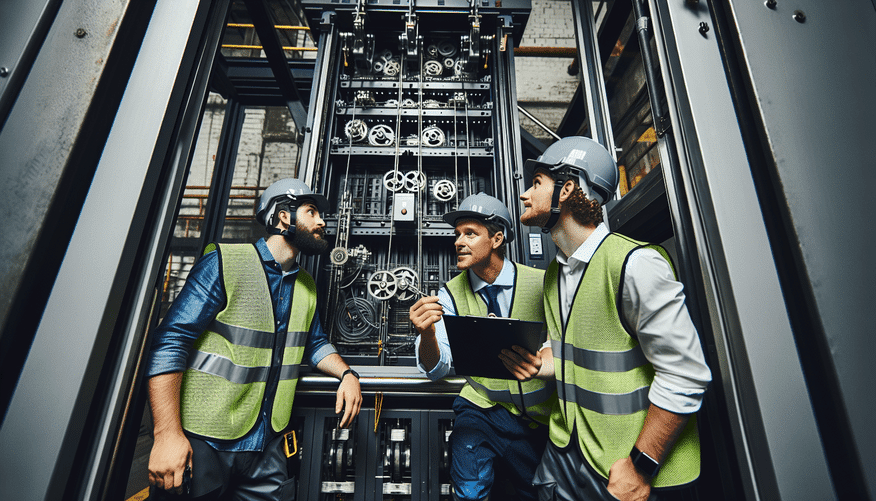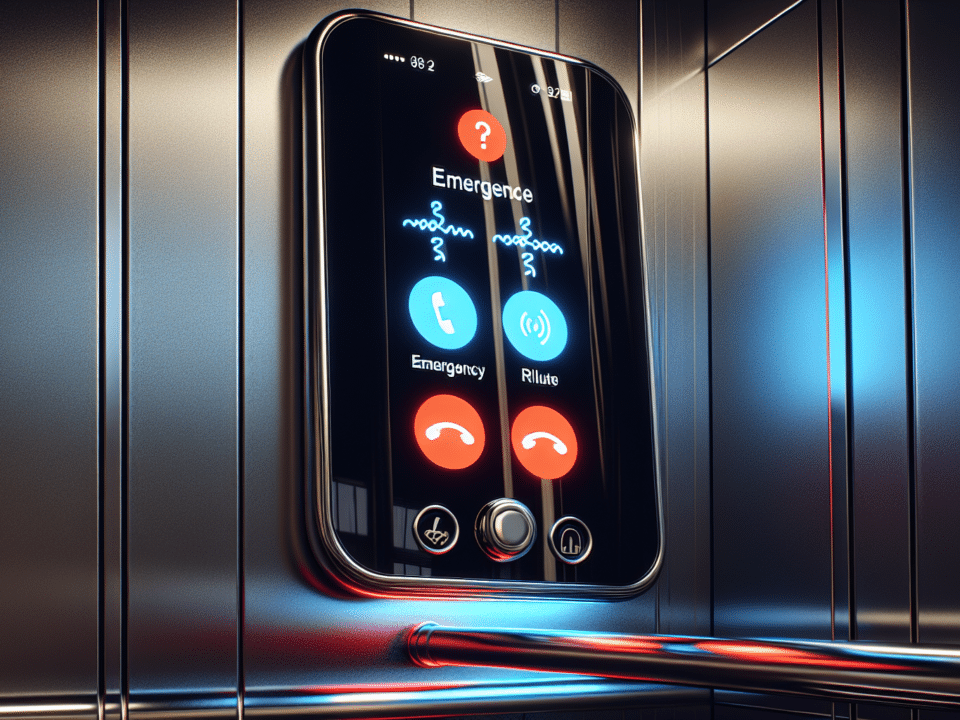
Powerful Guide to the Most Updated Emergency Pool Phones
February 22, 2024
Does an Elevator Require a Dedicated Phone Line?
February 22, 2024Concerned about elevator safety? You’re not alone. Elevator travels are incredibly safe, yet accidents can happen. This guide cuts through the complexities and delivers the practical safety measures every elevator rider and building owner should know. From proper behavior on approach to how to handle emergency situations, we’ve got you covered. Plus, we delve into the important roles of building owners and maintenance staff in keeping these essential machines in top condition.
Key Takeaways
- Elevator safety requires mindfulness from riders, including being aware of tripping hazards, ensuring the elevator is level with the floor before entering, holding handrails during the ride, and remaining calm and considerate when exiting the elevator or during emergencies.
- Preparedness for elevator emergencies, such as being trapped in a stalled elevator or a fire, is essential. Protocols include using alarms and emergency buttons, not using elevators in case of a fire, and waiting for trained personnel for assistance rather than attempting self-rescue.
- Elevator safety for building owners includes regular maintenance and inspections, necessary training for elevator operators and maintenance staff, modernizing outdated elevator systems, and adhering to regulations and standards set by agencies like OSHA and ASME.
Elevator Safety Tips for Riders
Statistically, elevators have a strong track record of safety and security. According to ConsumerWatch.com, there are approximately 18 billion passenger trips per year in elevators in the United States. There are 27 fatalities and over 10,200 injuries annually in the U.S. alone due to elevator-related incidents. Understanding and adhering to elevator safety tips is paramount. It goes beyond just rules and regulations; it’s about personal responsibility and protecting both ourselves and our fellow passengers.
This entails mindfulness in how we approach, enter, ride, and exit the elevator. Being aware of potential hazards, such as tripping, entangled clothing, and being struck by closing doors, is imperative. Furthermore, we need to comprehend how to respond during emergencies. We will examine each of these aspects in detail.
Approaching Elevators
The journey begins even before we step into the elevator. It starts when we approach the elevator. How we do this can significantly impact our safety. So, what’s the safe way to approach an elevator? It involves being calm and being aware of potential hazards like tripping and being struck by closing doors.
It also means being considerate of others. Stand clear of the elevator doors and make way for exiting passengers. And remember, pressing both the up and down buttons does not make the elevator arrive quicker. Instead, it’s best to wait for the next elevator to arrive.
Entering and Riding Elevators

After approaching the elevator, the next step is entering it. This might seem like a simple task, but it comes with its own set of safety measures. When the elevator arrives and the doors open, watch your step. Make sure the elevator car is level with the floor before stepping in, as you would when getting into your next car.
Once inside, follow these guidelines:
- Stand clear of the doors and make sure your clothes and carry-ons are away from the doors.
- During the ride, if the elevator stops at a floor that isn’t yours, be considerate. Allow other passengers to exit before you enter.
- Always hold the handrail, because you never know when the elevator might jerk or stall.
Exiting Elevators

Exiting the elevator might seem like the easiest part of the journey, but it’s crucial to be just as mindful during this phase. When your floor arrives, wait until the elevator stops completely before attempting to exit.
Be aware of your surroundings to avoid potential hazards and don’t try to push the door open manually, as this can lead to accidents. And remember, just as you made way for exiting passengers while entering, ensure you exit swiftly through the closing door to allow incoming passengers nearest to enter. In case someone stops push the door, be patient and wait for the door to function properly.
Elevator Emergency Situations

Despite the hope for smooth and uneventful elevator journeys, preparedness for unexpected situations is crucial. Emergencies can arise from various factors, including:
- Mis-leveling
- Excessive speed
- Door strikes
- Inadequate maintenance
- Safety inspections
How do you navigate these situations?
We will explore common emergency scenarios such as a stalled elevator, a fire, among others. In each of these situations, the key is to stay calm, follow the safety protocols, and wait for qualified help.
Stalled Elevator
Being trapped in a stalled elevator can be an unnerving experience. But remember, panicking won’t help. What will help is pressing the elevator’s alarm button to signal for assistance.
While waiting for help, follow these steps:
- Stay clear of the door and refrain from attempting to force it open.
- Do not let your feet slide under the elevator door, as it can lead to accidents.
- It might be tempting to try and get out on your own, but it’s safer to wait for trained emergency personnel to assist you.
Fire Emergency
In the event of a fire, the elevator should be the last place you want to be. Why? Because the heat from a fire can cause specific problems for elevator control equipment, rendering them unsafe. So, what should you do instead?
The ideal protocol during a fire emergency is to refrain from using the elevator and evacuate the building using the stairs. If you find yourself trapped in an elevator during a fire, press the emergency button or use an emergency phone to request assistance while maintaining composure.
Other Emergencies
Other emergencies, like earthquakes or hurricanes, also require specific safety measures, such as emergency lighting and floor indications. During an earthquake, for instance, press all the floor buttons in the elevator and disembark at the earliest opportunity.
In a hurricane, it is advised to operate the car to the mid-point of the hoistway and disconnect the main power supply to ensure the safety of the elevator. Remember, in all emergency situations, the primary goal is your safety.
Elevator Safety for Building Owners and Workers

Now, shifting perspectives, we will examine elevator safety from the viewpoint of building owners and workers. After all, they are the ones responsible for ensuring that the elevators we ride are safe and well-maintained. What does this encompass?
It involves regular maintenance and inspections, training for elevator operators and maintenance staff, and modernizing outdated elevator systems. We will examine each of these aspects in detail.
Regular Maintenance
Regular maintenance is crucial to ensuring the safe operation of elevators. This includes monthly maintenance services to identify loose screws and noisy wheels, as well as annual equipment testing to adhere to local government regulations.
Passenger elevators should undergo maintenance inspections at least four times a year, while freight elevators can suffice with inspections twice a year. These regular inspections and maintenance help prevent elevator-related injuries and ensure a smooth ride for passengers.
Employee Training
Proper training for elevator operators and maintenance staff is key to ensuring elevator safety. This involves completing essential training programs such as:
- The Elevator and Escalator Inspectors Certification by the National Association of Elevator Safety Advocates
- The Apprentice Program by the Joint Apprentice Training Committee of the Elevator Industry
- Elevator apprenticeship courses provided by NEIEP.
Additionally, building personnel should undergo safety training courses like the OSHA 10-Hour General Industry course and the Elevator Field Safety Course, a self-study program. This ensures that they are well-equipped to handle any elevator-related issues or emergencies.
Elevator Modernization
Modernizing elevators is another critical aspect of elevator safety. This involves enhancing vital components of the elevator to improve its performance, energy efficiency, and safety.
Elevator modernization can also include transforming traditional controls to destination dispatching for additional advantages. It contributes to safety by incorporating features like safety brakes, emergency evacuation feature, and door sensors.
Cellular Elevator Phones
Cellular elevator phones revolutionize safety by bypassing unreliable landlines and ensuring clear communication even in power outages. Their wireless connection pierces through metal shafts, allowing passengers to instantly contact emergency services during entrapments, medical emergencies, or any other issue. Two-way communication calms passengers, aids first responders in pinpointing location, and facilitates rapid resolution, making elevators safer and less stressful for everyone.
Safety Resources and Regulations
Having discussed safety measures and best practices, we now turn to the legalities and resources. There are specific regulations and standards that elevators must adhere to ensure safety. These regulations are enforced by various regulatory agencies, and there are additional resources available for further information.
Regulatory Agencies
Agencies like the Occupational Safety and Health Administration (OSHA) are accountable for ensuring compliance with safety standards for elevators. The American Society of Mechanical Engineers (ASME) plays a pivotal role in developing and publishing the ASME A17.1 / CSA B44 Safety Code for Elevators and Escalators.
Additional Resources
Apart from the regulations and agencies, there are additional resources available for more information on elevator safety. Books like ‘Surviving Your Elevator Entrapment: and the Truth about Elevator Safety’ by JF Lewis and ‘Elevator & Escalator Rescue: A Comprehensive Guide’, especially beneficial for emergency service providers, provide comprehensive information on elevator safety.
Safety courses like the Elevator Field Safety Course and the program ‘A Safe Ride: Safety for Adult Riders’ offer practical guidance on elevator safety.
Podcasts like the Elevator Radio Show Podcast and Elevator World’s podcasts offer valuable updates and developments in the elevator and vertical transportation industry.
Summary
So, there you have it – a comprehensive guide to ensuring a safe vertical journey. We’ve discussed safety tips for riders, handling emergencies, the responsibilities of building owners and workers, and the resources and regulations in place. Remember, elevator safety is not just about following regulations; it’s about personal responsibility. It’s about ensuring our safety and that of our fellow passengers. So the next time you step into an elevator, remember these tips and make your journey a safe one.
Frequently Asked Questions
What are the basic elevator safety?
The basic elevator safety includes allowing others to board and exit easily, not overloading the elevator, not trying to leave a moving elevator, and using in-car emergency devices in case of an emergency. It’s also important to pay attention to floor indications and not try to stop closing doors.
What are the do’s and don’ts of elevator safety?
When using an elevator, be cautious when boarding and exiting, avoid overcrowding, and never use your hand or an object to keep the door open. Always contact emergency responders if you get stuck, and remain calm in any situation to ensure safety.
What are the golden rules of elevators?
The golden rules of elevators include standing clear of the doors, not overloading the elevator, and using in-car emergency devices in case of an emergency. Always remember to hold children and pets firmly and ask someone to push the door open button if needed.
What should I do if I’m trapped in a stalled elevator?
If you’re trapped in a stalled elevator, stay calm and press the elevator’s alarm button to signal for assistance. Use the emergency phone. Avoid trying to force the door open.
Should I use the elevator during a fire?
No, it’s important to refrain from using the elevator during a fire and to use the stairs to evacuate the building instead.




